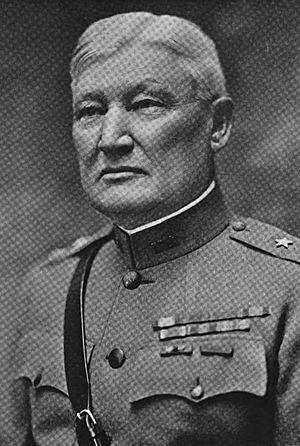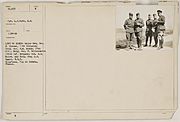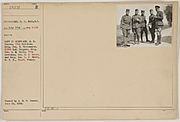Edmund Wittenmyer facts for kids
Quick facts for kids
Edmund Wittenmyer
|
|
|---|---|

From 1927's History of the Seventh Division, United States Army, 1917-1919
|
|
| Born | April 25, 1862 Buford, Ohio |
| Died | July 5, 1937 (aged 75) Washington, D.C. |
| Place of burial | |
| Allegiance | United States |
| Service/ |
|
| Years of service | 1887–1923 |
| Rank | |
| Unit | U.S. Army Infantry Branch |
| Commands held | Company D, 15th Infantry 153rd Infantry Brigade, 77th Division 7th Division Fort D. A. Russell |
| Battles/wars | Spanish–American War China Relief Expedition Philippine–American War Second Occupation of Cuba Mexican Border War World War I |
| Awards | Army Distinguished Service Medal Legion of Honor (Commander) (France) Croix de Guerre with Palm (France) |
| Other work | Teacher Farmer |
Edmund Wittenmyer (born April 25, 1862 – died July 5, 1937) was an important officer in the United States Army. He served in many wars, including the Spanish–American War and World War I. He became a Major General. He was best known for leading the 153rd Infantry Brigade and the 77th Division during World War I. He also commanded the 7th Division in that war.
Contents
Early Life and Education
Edmund Wittenmyer was born in Buford, Ohio on April 25, 1862. His parents were Daniel G. and Rebecca Ann Wittenmyer. He went to school in Highland County, Ohio. When he was 15, he started teaching school in West Union, Ohio.
In 1883, he was accepted into the United States Military Academy. This is a famous school for training Army officers. He graduated in 1887. He was ranked 55th in his class of 64 students.
Starting His Army Career
After graduating, Wittenmyer became a second lieutenant in the Infantry. He joined the 9th Infantry Regiment. He was first stationed in San Diego Barracks, California, until 1891. Later, in 1892, he moved to Fort Wingate, New Mexico. In 1893, he worked at the World's Columbian Exposition in Chicago.
Wittenmyer studied at the Infantry and Cavalry School from 1893 to 1895. He was promoted to first lieutenant in 1894. After that, he served with the 15th Infantry. He was at Fort Sheridan, Illinois and Fort Bayard, New Mexico. At Fort Bayard, he worked as a quartermaster and then as an adjutant for his regiment.
Serving in Wars and Conflicts
During the Spanish–American War, Wittenmyer was first sent to Fort Huachuca, Arizona. His regiment patrolled the border with Mexico. In November 1898, he was in Huntsville, Alabama. His regiment was waiting to go to Cuba. In January 1899, he was assigned to duty in Puerto Principe, Cuba. In March 1899, he was promoted to captain.
In July 1899, Wittenmyer returned to the United States. He was still with the 15th Infantry. In the autumn of 1899, his regiment took part in the China Relief Expedition. This was a mission to help people in China. When the Army formed brigades in China, Wittenmyer became an adjutant for the Second Brigade. He then commanded Company D, 15th Infantry. This company was sent to Legaspi, Cagdianao during the Philippine–American War. He fought in several missions against Filipino rebels. In February 1902, he worked as a temporary paymaster in Manila. He came back to the United States in April 1903. He continued his paymaster duties in Washington, D.C..
More Career Milestones
In March 1906, Wittenmyer joined the 5th Infantry at Plattsburgh Barracks, New York. In October 1906, his regiment went to Cuba. They were part of the Army of Cuban Pacification during the Second Occupation of Cuba. He served there until 1908. When he returned to the United States, Wittenmyer became the adjutant for the 5th Infantry. He held this job until January 1910.
Wittenmyer worked on the Army General Staff from January 1910 to March 1911. In February 1911, he was promoted to major. In April 1911, he helped decide where to build Army and National Guard training sites. After working at the War College, Wittenmyer joined the 27th Infantry at Fort Sheridan, Illinois. In February 1913, he was with the 27th Infantry in Texas City, Texas. They were there to secure the border during the Mexican Revolution.
In July 1913, Wittenmyer became a U.S. military attaché in Havana, Cuba. He was also a military advisor to the president of Cuba. He stayed in this role until the summer of 1917. He was promoted to lieutenant colonel in July 1916 and colonel in May 1917.
World War I Service
In August 1917, Wittenmyer was promoted to temporary brigadier general for World War I. He was given command of the 153rd Infantry Brigade. This unit was part of the 77th Division. The brigade arrived in France in April 1918. They finished their training in the Calais Sector. In June 1918, they took over from the 42nd Division on the front lines of the Baccarat Sector.
On August 3, 1918, Wittenmyer's brigade moved to the Vesle Sector with the 77th Division. They stayed there until August 13. Then, they took part in attacks to cross the Vesle River and advance to the Aisne River. The 77th Division then marched to the Argonne Sector. They held defensive positions there until September 25. On that day, they joined the Meuse–Argonne offensive.
Wittenmyer was promoted to major general on October 1, 1918. The 153rd Brigade continued its attacks until October 15. They even captured Saint-Juvin from the Germans. On October 24, Wittenmyer took command of the 7th Division. This division participated in the final attacks of the war. After the armistice ended the war, Wittenmyer remained in command of the 7th Division. They held positions near Toul, France.
For his service in World War I, Wittenmyer received the Army Distinguished Service Medal. He also received two awards from France: the Legion of Honor (Commander) and the Croix de Guerre with Palm.
After World War I
Wittenmyer was part of the post-war occupation of Germany. He stayed in command of the 7th Division until it returned to the United States. The 7th Division was disbanded on June 20, 1919.
After the war, Wittenmyer returned to his permanent rank of colonel. He became the chief of staff for the Ninth Corps Area. In 1922, he was promoted to permanent brigadier general. He was assigned as commander of Fort D. A. Russell, Wyoming. He remained in command until he retired in August 1923.
Retirement and Passing
Wittenmyer never married and did not have children. After retiring, he lived with his sister-in-law and her family. They lived near Peebles, Ohio. He also ran a farm in nearby Lawshe, Meigs Township. In 1930, a new law allowed World War I generals to retire at their highest rank. So, Wittenmyer was promoted to major general on the retired list.
In 1936, Wittenmyer became ill after a car accident. He sought treatment at the military hospital in Hot Springs, Arkansas. He was diagnosed with cancer. His left arm was removed to try and stop the cancer from spreading.
Wittenmyer's health did not get better after the surgery. He passed away at Walter Reed Hospital on July 5, 1937. He was buried at Arlington National Cemetery.
Photos




